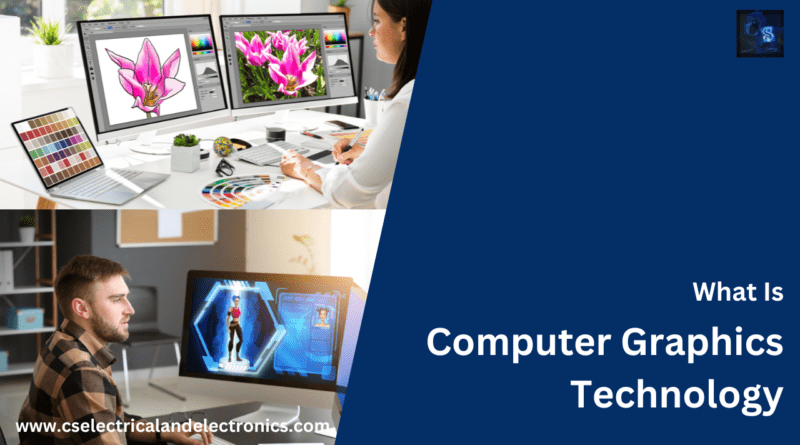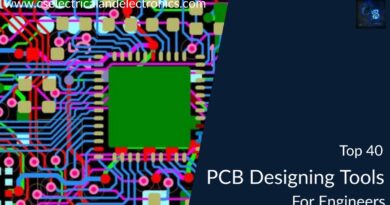What Is Computer Graphics Technology, Working, Benefits, Uses
Hello guys, welcome back to our blog. Here in this article, we will discuss what is computer graphics technology, working of it, the benefits of computer graphics, the future of it, and applications of computer graphics.
If you have any electrical, electronics, and computer science doubts, then ask questions. You can also catch me on Instagram – CS Electrical & Electronics.
Also, read the following:
- What Is Air Gen Technology, Working Of Air Gen, Diagram, Benefits
- AI Tools For Electronic Circuit Design, Which Is Best?
- AI Artificial Intelligence Applications In Electric Vehicles | Future?
Computer Graphics Technology
The branch of computer science that deals with the production of visuals and animation is known as computer graphics. It is a broad field that includes a wide range of methods and tools.
The creation of realistic and aesthetically pleasing visuals is the aim of computer graphics. Many methods, including rasterization, ray tracing, and volumetric rendering, can be used to accomplish this.
A wide range of industries uses computer graphics, including web design, product design, medical imaging, cinema and television, video games, and scientific visualization.
Computer graphics is a field that is continually changing. As technology develops, new methods and tools are created that make it possible to produce animations and images that are ever more lifelike and engaging.
The fundamentals of computer graphics, including the various methods used to produce visuals and animation, will be covered in this article. We’ll also talk about some of the most exciting developments in computer graphics and the field’s future.
What is Computer Graphics Technology?
The branch of computer science that deals with the production of visuals and animation is known as computer graphics. It is a broad field that includes a wide range of methods and tools.
The creation of realistic and aesthetically pleasing visuals is the aim of computer graphics. Several methods, including the following, can be used to accomplish this:
01. Rasterization is the method used the most frequently to create graphics for computer screens. It entails separating the image into a grid of pixels and giving each one a color.
02. Ray tracing is a more sophisticated method for more realistically producing visuals. It entails estimating each pixel’s color depending on the objects with which the light rays intersect after following their journey across a scene.
03. Volumetric rendering: This method is used to produce graphics that depict large amounts of data. For instance, it can be used to provide accurate representations of clouds, smoke, and other natural phenomena.
How Does Computer Graphics Work?
In order for computer graphics to function, images must be created using a computer and presented on a screen. The object or scene that the computer intends to depict is first modeled by the computer. Points, lines, triangles, and other shapes can be used to construct this model.
The color of each pixel in the image is then determined by the computer using a rendering engine. The positioning of the light sources, the characteristics of the scene’s objects, and the orientation and location of the camera are all taken into account by the rendering engine.
The last image is then shown on the screen.
Rasterization and ray tracing are the two primary methods used in computer graphics to create images.
Rasterization
When it comes to producing images for computer screens, rasterization is by far the most popular method. It entails splitting the image into a grid of pixels and giving each pixel a color.
Each pixel’s color is determined by its location in the grid, the characteristics of the object it depicts, and the lighting conditions of the scene. Rasterization is a quick and effective method, but it can only produce images with flat surfaces.
Tracing rays
A more sophisticated method for producing more realistic visuals is ray tracing. It entails estimating each pixel’s color depending on the objects with which the light rays intersect after following their journey across a scene.
Rasterization is a less computationally expensive technique than ray tracing, yet ray tracing can produce considerably more realistic visuals.
In computer graphics, a variety of different methods are employed to create images in addition to rasterization and ray tracing. These methods consist of:
- Utilizing this method, visuals representing large amounts of data are produced. It can be used, for instance, to produce accurate representations of clouds, smoke, and other natural occurrences.
- Procedural generation is a method for autonomously producing graphics. To generate realistic surroundings and objects, it is frequently employed.
- Deep learning: Realistic visuals and animations can be produced using this kind of machine learning. For making realistic facial expressions and bodily movements, it is frequently employed.
The field of computer graphics is intricate and dynamic. As technology develops, new methods and tools are created that make it possible to produce animations and images that are ever more lifelike and engaging.
Benefits of Computer Graphics
The use of computer graphics offers a number of advantages. Among the most significant advantages are:
01. Realism: Images that are extremely realistic can be produced using computer graphics. This can be used to produce accurate models of real-world items and surroundings or to produce special effects for movies and television shows.
02. Immersion: Immersive experiences can be produced using computer graphics. Virtual reality or augmented reality technology can be used to do this.
03. Creative expression is possible with computer graphics. This can be accomplished by producing fresh and creative visuals and animations.
04. Communication: Information can be conveyed through computer graphics. Infographics, presentations, and teaching materials can all be made to do this.
Future of Computer Graphics Technology
Computer graphics is a field that is continually changing. As technology develops, new methods and tools are created that make it possible to produce animations and images that are ever more lifelike and engaging.
Future advancements in computer graphics that look very promising include:
01. Real-time ray tracing is a novel method that enables the instantaneous production of realistic visuals. This allows for the creation of interactive experiences because the visuals may be seen as they are being generated.
02. Users can fully immerse themselves in a virtual environment thanks to the technology known as virtual reality (VR). Experiences like gaming, education, and training are being developed with this technology.
03. In augmented reality (AR), virtual things are superimposed on the physical world. Through the use of this technology, new and creative methods of interacting with our surroundings, such as navigation, commerce, and gaming, are being developed.
Applications of Computer Graphics
There are many different uses for computer graphics, including:
- Film and television: Computer graphics are used to produce titles, animation, and special effects in motion pictures and television programs.
- Video games: The settings and characters in video games are created using computer graphics.
- Web design: The visuals and animations you see on websites are made using computer graphics.
- Product design: Before things are made, prototypes and models are created using computer graphics.
- Medical imaging: To make images of the human body for use in medical diagnosis and therapy, computer graphics are utilized.
- Scientific visualization: Images of scientific data are produced using computer graphics. This can assist scientists in comprehending and explaining their findings.
Conclusion
A variety of visuals and animations can be produced using the potent instrument of computer graphics. We can anticipate seeing even more incredible and lifelike graphics and animations generated in the future as the area develops.
This was about “Computer Graphics Technology“. I hope this article may help you all a lot. Thank you for reading.
Also, read:
- What Is Vector CANoe Tool, Why It Is Used In The Automotive Industry
- What Is TCM, Transmission Control Module, Working, Purpose,
- Driver Monitoring Systems In Vehicles, Working, Driver Sleepy Alert
- Top 100 Automotive Interview Questions With Answers For Engineers
- Cybersecurity Trends And Challenges In The Digital Age
- Natural Language Processing (NLP) In Computer Science
- Data Science In Action: Real-World Applications
- Autonomous Vehicles: The Future Of Transportation
Author Profile
- Chetu
- Interest's ~ Engineering | Entrepreneurship | Politics | History | Travelling | Content Writing | Technology | Cooking
Latest entries
 All PostsApril 19, 2024What Is Vector CANoe Tool, Why It Is Used In The Automotive Industry
All PostsApril 19, 2024What Is Vector CANoe Tool, Why It Is Used In The Automotive Industry All PostsApril 13, 2024What Is TCM, Transmission Control Module, Working, Purpose,
All PostsApril 13, 2024What Is TCM, Transmission Control Module, Working, Purpose, All PostsApril 12, 2024Top 100 HiL hardware in loop Interview Questions With Answers For Engineers
All PostsApril 12, 2024Top 100 HiL hardware in loop Interview Questions With Answers For Engineers All PostsMarch 22, 2024Driver Monitoring Systems In Vehicles, Working, Driver Sleepy Alert
All PostsMarch 22, 2024Driver Monitoring Systems In Vehicles, Working, Driver Sleepy Alert








